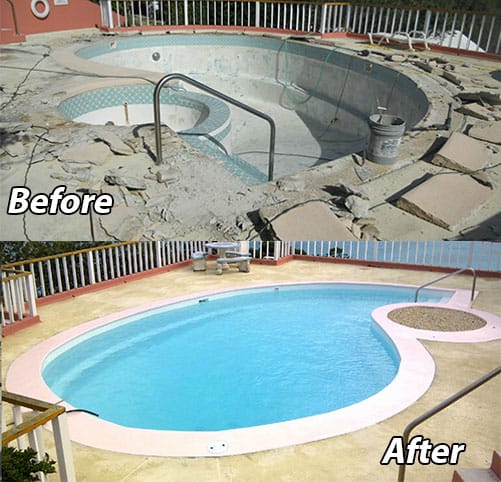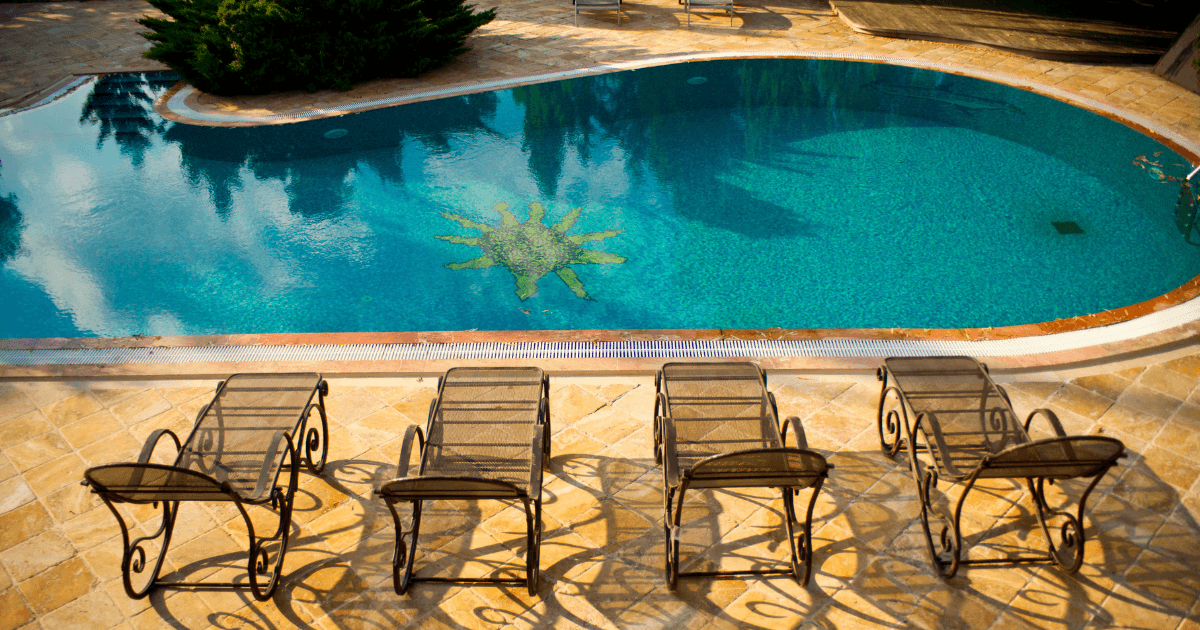Introduction
Well-done repair project can make your backyard oasis look completely different. Resurfacing isn’t just for looks; it’s also important for keeping your pool safe and making it last longer. The cost for a homeowner can range from $4,000 to $15,000, based on the size of their pool and the products they choose. Use a pool cost calculator to estimate your specific expenses. This range may seem big, but don’t worry, I’ll help you sort through the choices and find the best one for your pool and your budget. Let’s get started and look at some ways to make your pool look better without spending a lot of money.
The Basics of Pool Resurfacing Costs

Knowing the basics of how much pool resurfacing costs can help you make a good budget if you want to give your pool a new look. The price range for a pool that’s 1,000 square feet is usually between $6,000 and $11,000. The price can range from $4,000 to $10,000, though, depending on things like the size of your pool, the materials you choose, and even where you live. Most of the time, resurfacing a concrete pool costs around $6,500 for every 1,000 square feet. It is a good purchase that will make your pool look and work better. Concrete is strong and has a classic look, but it needs to be maintained regularly to stay in great shape. The costs are a bit higher if you choose fiberglass between $16,000 and $26,000 each. Fiberglass is liked because it lasts longer and has a better surface, which can mean less maintenance over time.
Cost Breakdown by Pool Type and Material
Resurfacing your pool can cost a lot of different amounts, based on the type of pool and the materials that are used. For example, concrete pools are a bit pricey, but there’s a good reason for that. They last a long time and can be made to fit different shapes and sizes. Putting a new surface on a concrete pool usually costs between $10,000 and $15,000. This includes a lot of work, like taking off the old finish, fixing anything that needs fixing, and putting on a new coat of plaster. Read our expert guide to Gunite pool repairs to understand why this is important.
Putting a new surface on a plastic pool, on the other hand, would cost less. Because the shell of these pools is made of a single piece of pre-formed fiberglass, it is less likely to wear down like concrete pools do. It costs around $4,500 to $6,500 to resurface a plastic pool. This price includes cleaning the shell and putting on a new gel coat that makes your pool look brand new. Both ways will make your pool last longer and look better, so you can get the most use out of your garden oasis for the money. Whether you choose fiberglass or concrete, a good refinishing job will save you money in the long run and give you many more years of swimming fun.
Factors Influencing the Cost of Pool Resurfacing
Putting a new surface on your pool can really make your backyard look better, but how much it will cost will depend on a number of things. To begin, where you live is very important. In some places, like California, the cost of work and materials may be higher than in Texas. When it comes to products, the one you choose has a big impact on the price. Because it’s cheap, plaster is a popular choice. It might cost less than more lasting but more expensive choices like rock or tile finishes. Don’t forget that size does matter! The cost goes up because a bigger pool needs more materials and work. When planning your pool job, you should always keep these things in mind to avoid shocks! These tips will help you make smart decisions that will save you money and make your pool last longer.
The Financial Implications of Pool Size and Shape

To understand how different pool sizes and shapes affect the cost of refilling, it’s important to know that bigger pools and pools with complicated shapes usually cost more. This is because patterns that are more complicated need more work and supplies. For example, a kidney-shaped pool not only looks nicer, but it also costs more because it takes longer to resurface because of all the curves. A normal rectangle pool might cost around $5,000 to resurface, but that price can go up a lot if you add curves, steps, or other unique features. To keep costs down, think about how a simpler design that is easy to maintain and repair will help in the long run. Remember that the key to getting the most out of your pool investment is finding a balance between how you want it to look and how much maintenance it needs.
Choosing the Right Material for Your Pool
Picking the right material for redoing your pool is important for many reasons, including how it looks and how easy it is to keep up. Plaster is the most common and least expensive choice. It usually only needs to be touched up every 5 to 10 years. It feels smooth to the touch and is easy to take care of. Pebble finishes are great if you want something that will last and look natural. They last between 15 and 20 years and cost more than plaster, but they are worth it because they don’t stain or grow algae. Fiberglass is great for people who want an option that doesn’t need much upkeep. Learn more about pool maintenance tips to keep your fiberglass pool in top condition. It looks good, doesn’t need as many chemicals, and can last for more than 25 years. Each material has its own pros and cons, so think about what’s most important to you for your pool, whether it’s cost, durability, or how easy it is to clean. Explore different pool resurfacing materials to make an informed decision.
Additional Costs to Consider
When figuring out how much it will cost to resurface your pool, it’s important not to forget about the smaller costs that can add up quickly. For example, you’ll have to empty, clean, and replace your pool. The cost of this can change a lot based on the size of your pool and the water rates where you live. A lot of people forget to include it in their budget, but believe me, it’s important! During the process, you may also find fixes that you didn’t expect, like cracks or leaks that were hidden under the old surface. It is important to deal with these issues right away so that they don’t get worse over time. Do not forget about the extras that you can choose to have. Adding new tiles or machines that use less energy can make your pool look better and work better, but they will cost more total. To avoid shocks, always include these in your first budget. Understand the causes and solutions of pool deck crack repair. Don’t forget that spending a little more now can save you a lot more later!
DIY vs. Professional Pool Resurfacing

If you want to resurface your pool, the choice between doing it yourself and getting a pro depends on a number of factors, but the main ones are cost and quality. A skilled job can cost anywhere from $4,000 to $7,000, based on the size of the pool and the type of materials used, like clay, pebble, or fiberglass. DIY parts, on the other hand, might only cost $2,000 to $3,000. But the real value of skilled refinishing is in how it will help you in the long run. Professionals are more accurate and use better materials, so the finish can last up to 15 years, compared to the 5 years that many do-it-yourself jobs last. Anyone who wants to do it themselves needs to know a lot about basic building and the tools they will be using. You might want to save money up front, but keep in mind that a bad job can cost you more in the long run. Most people think it’s worth the money to hire pros because they offer longevity, a guarantee, and peace of mind.
Long-term Savings from Pool Resurfacing
Resurfacing your pool is not only a nice way to make it look better, it’s also a smart financial move that will save you money in the long run. By choosing modern products that use less energy, you can cut down on upkeep costs by a lot. For example, high-quality options to plaster like rock or fiberglass last longer and are better at stopping algae growth, which means you need to use fewer chemicals and clean them less often. Adding energy-saving features like LED pool lights and variable speed pumps during refilling can also save you up to 90% on energy costs! Additionally, finding the perfect horsepower pump for your pool can optimize energy efficiency. The lower power prices will pay for these improvements over a few years. You can think of it as an investment in your home that will not only make swimming better but also save you money on everyday costs. Trust me, making these changes when you resurface your pool is a smart choice that will save you money in the long run.
Conclusion
Resurfacing can truly improve the look and usability of your pool. Whether you choose clay, pebbles, or fiberglass, the right material will not only make your pool look better, but it will also make it last longer and be safer overall. The cost of resurfacing a pool depends on its size, the material used, and its position. However, the extra years of pleasure and lower upkeep costs make it well worth the money. Choose high-quality materials and think about making changes that use less energy during the building process. This will save you money on repairs and energy bills in the long run. So jump in! Resurfacing your pool today will make it look better, last longer, and cost less. That’s why you should do it. Make your pool the best thing about next summer!
Frequently Asked Questions (FAQs)
1. Is it worth resurfacing a pool?
Yes, resurfacing a pool is worthwhile as it extends its lifespan, enhances safety, and improves overall aesthetics.
2. How often should a swimming pool be resurfaced?
Swimming pools generally need resurfacing every 10 to 15 years, depending on usage and maintenance.
3. What is the best type of pool resurfacing?
Pebble finishes are highly recommended for their longevity and attractive appearance, though choices vary based on budget and preference.
4. How much does it cost to resurface concrete around a pool?
The cost typically ranges from $10 to $15 per square foot, influenced by the area size and chosen materials.






